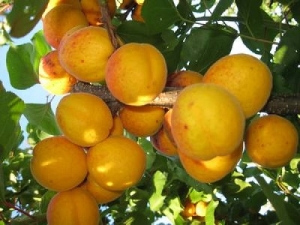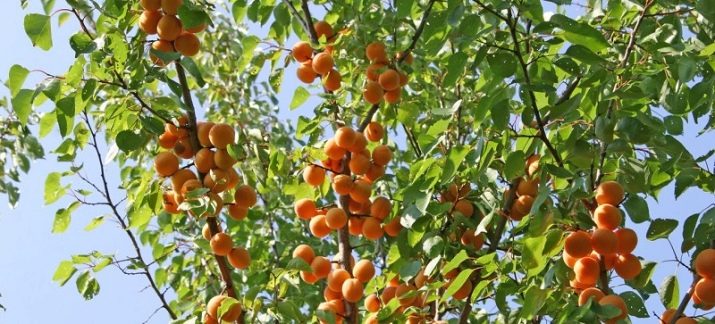How to grow apricot variety "Orlovchanin"?

There is a large variety of varieties of apricots: there are about a thousand.Each of them has its own differences: in terms of ripening, the form of leaves and fruits, resistance to external conditions, pests and diseases, conditions of care. Different varieties have their own notes in taste: some can be sour, others - very sweet. Each gardener finds his favorite variety by experimental method, starting from the reviews or based on the description.
Those who have not yet made their choice, it will be useful to learn how to grow apricot varieties Orlovchanin.
general characteristics
This variety characterizes the following.
- Apricot "Orlovchanin" has sweet fruits or with a slight sourness. It is grown on an industrial scale. They are good fresh, but they also make very tasty canned compotes, jam, jam, jam.
- Fruiting begins in the third year of life, the crop is usually harvested in late July or early August. Apricot fruit of this variety every year, subject to proper care.
- The tree reaches a height of three meters and has a voluminous crown; the bark of a healthy tree is smooth to the touch and has a brown color. It is believed that this is a medium grade variety.
- The leaves are elongated with a sharp tip. Petioles are usually long and dense.
- The kidneys are often located together in three, extremely rarely - singly. The flowers are medium in size and have a white color and a cup in the shape of a glass.
- Fruits are oval, yellow, sometimes in some places of a pink shade, can have specks of brown color. Typically, the weight of the fruit is about thirty or forty grams, growing inside the crown crowded. The pulp is dense, easily separated from the bone, the core of which has a sweet taste.
Cultivation and care
Apricot loves the heat and the sun, and the wind is contraindicated to him. Most often, planting is done in mid-April, but the place for the future habitat of the tree is prepared in the fall. The depth of the landing pit is about eighty centimeters. Ash, manure and phosphate are added to the soil. The recess to the third is filled with this composition, mixed with the ground, well compacted, poured into the pit two buckets of water. Pour some earth on top. Then carefully place the roots, fall asleep with the rest of the earth with fertilizers, compact the soil, and water it again. When planting trees are placed at a distance of at least three meters from each other.
Apricot of this variety, like many others, refers to self-pollinating trees. For a good harvest when active flowering occurs, it’s good if there are many bees around: they are the best pollinators. Apricots are considered attractive to insects: they are good honey plants. When apricots are grown on an industrial scale, about five families of bees are placed on one hectare of trees. In suburban areas, everything happens without special intervention, and usually this variety gives a good harvest.
Apricot care is simple. In watering, it is necessary to observe the golden mean: it is impossible for a tree to experience a lack of moisture, but at the same time, an excess can also destroy the plant.
It is enough to water the tree twice a month. But if the weather is too hot and dry, you need to monitor the soil, check how dry it is. If it dries quickly, you can increase the number of waterings. Under the tree poured two buckets of water.
Feed the tree begin in the third year of life. The land must first be slightly loosened, and then fertilized in liquid form, after having dissolved the chicken droppings in water, observing the proportions of four hundred grams of droppings per ten liters of water. Before the inflorescences begin to form, you need to add a few tablespoons of nitrogen and potassium diluted in ten liters of water to the soil.
And although this variety is considered to be quite resistant to diseases and pests, prevention is still needed. To do this, trees are treated with insecticides. Apricots, like other fruit trees, can overcome aphid, moth, leafworm, thrips. In order to prevent wood treated in early spring.
If there is a frequent change of weather or rain, the tree can infect mold and fungus. This is visible on the bark: green or white growths appear. In these cases, the tree needs to be treated with a solution containing copper.
Reproduction and pruning
Gardeners share experiences and note that apricots are easy to grow from the seed. This can be done from spring to autumn. In the summer, they simply put a bone soaked in water in the ground, watering it all summer and loosening the soil slightly. In the fall, the seed is planted in moist soil. If the landing will be in the spring, until this time the bones are stored in wet sand in a dark cool room. Ideally, it should be a cellar or basement.
Before planting, the stones are in the water for three days and then placed in wet sawdust or sand. When the stone begins to crack and a sprout appears, you can put the apricot in the soil.
The optimal crown, as noted by gardeners, is sparse-tiered. To be such, it is necessary to produce the correct pruning. It is not necessary to allow the branches to grow from one place on the trunk. Skeletal branches should be laid at a large angle relative to the stem. Fruits are formed on the shoots at the age of one year, continuation shoots are especially good. In springtime, branches are cut in half to give birth to new buds. The crown should be thinned periodically to ensure good light access.
Advantages and disadvantages
The positive points include:
- the grade differs in high productivity;
- The fruits retain their appearance for a long time, they are easy to transport to various distances;
- Apricot "Orlovchanin" refers to frost-resistant varieties, which allows it to be grown in central Russia;
- fruits, in addition to jam and compotes, are wonderful dried apricots;
- and bone, and pulp, many housewives are used in home cosmetic procedures.
The main disadvantage is that when it is frost-resistant, the plant can suffer in severe frosts, that is, in the northern regions the tree may die if it is not properly protected.
In addition, reviews of some gardeners say that during a rainy summer, the tree strikes a fungus, so it must be constantly treated with special preparations in order not to lose the crop.
Any gardener, even a beginner, is easy to grow apricot, focusing on the rules of caring for him and taking into account the characteristics of the variety.
In the next video you will find the secrets of growing apricot in a harsh climate.



























